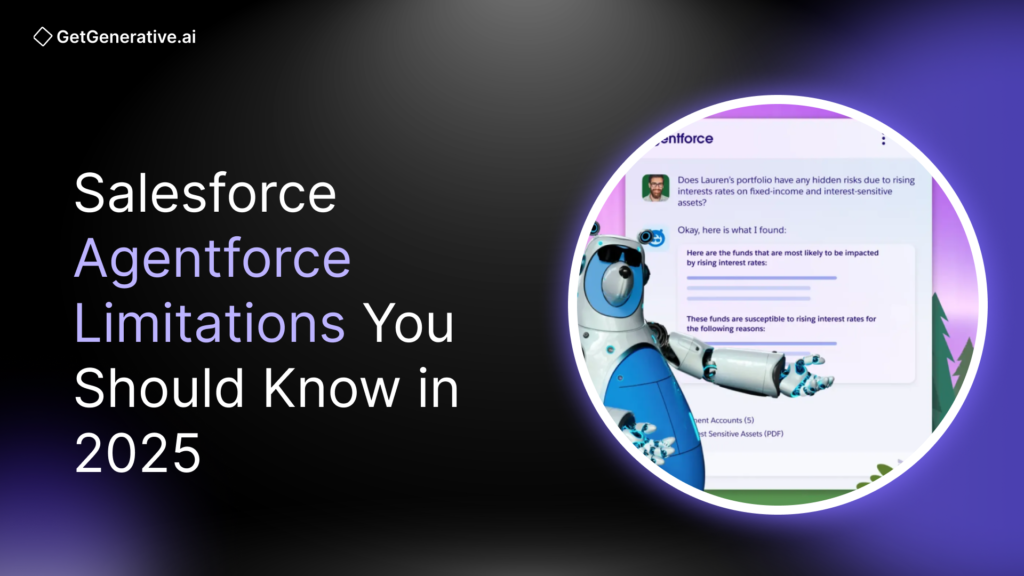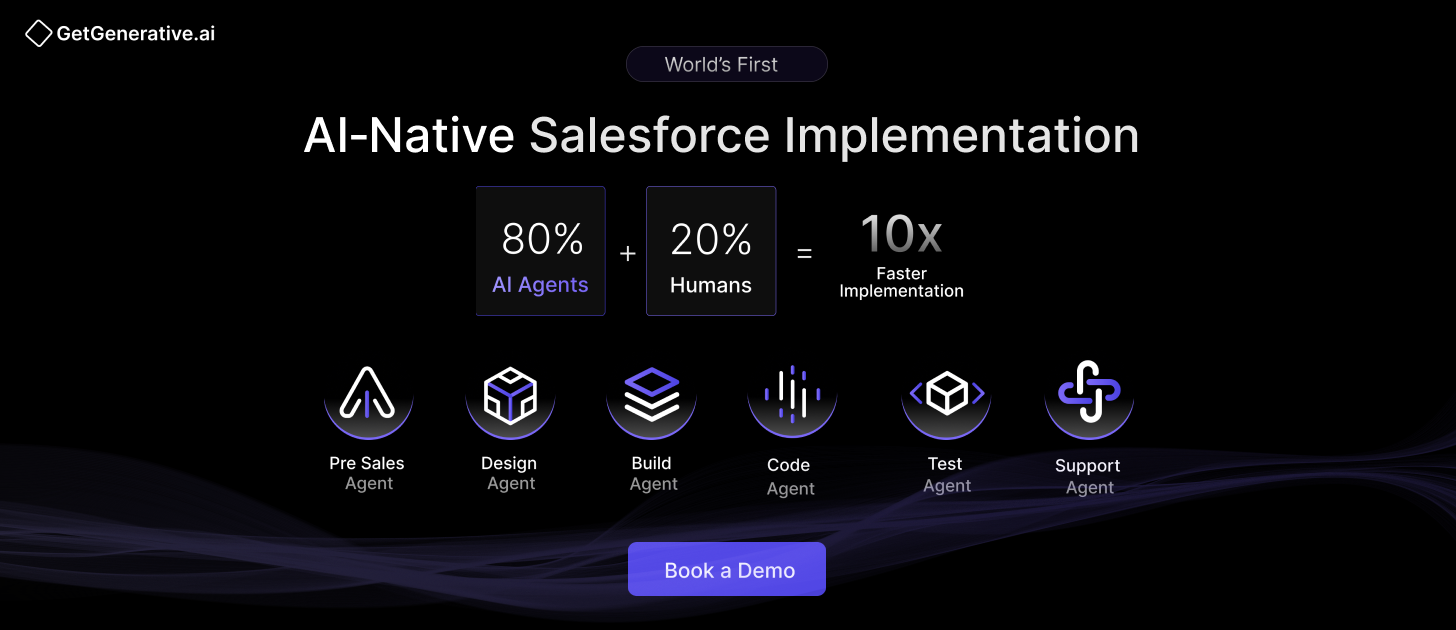Salesforce Agentforce Limitations You Should Know in 2025
Salesforce set an ambitious target of deploying one billion AI agents by 2025, but the ground reality paints a very different picture. By mid-2025, the platform had signed only 8,000 deals with relatively modest revenue growth, as confirmed by Salesforce CFO Amy Weaver.
While Agentforce offers impressive AI-powered automation capabilities, enterprise adoption has been slowed by pricing complexity, architectural restrictions, data quality dependencies, and regulatory hurdles. Understanding these limitations is essential for making informed investment choices and setting realistic expectations for implementation success. Let’s understand these limitations:
Complex Pricing Structure Creates Budget Uncertainty
Hidden Cost Multipliers and Ownership Expenses
At first glance, Agentforce pricing appears straightforward at $125–$150 per user per month, but the real costs run much deeper. The consumption-based model ($2 per conversation) combined with industry-specific premium add-ons creates budget unpredictability that can severely impact ROI.
Key cost drivers include:
- Multi-org support: $24,000 per org annually for add-ons like Net Zero Cloud. Large enterprises with multiple orgs often face six-figure annual expenses.
- Professional services: Implementation typically ranges from $50,000–$150,000, with ongoing consulting costing another $10,000–$25,000 per month.
- Government sector pricing: Specialized compliance pushes costs as high as $650 per user per month.
- Edition limitations: Agentforce requires Enterprise edition or higher, effectively locking out small and mid-sized businesses on Essentials or Starter editions.
For enterprises, the challenge isn’t just high costs—it’s the lack of cost predictability, which makes ROI calculation complex and uncertain.
ROI Realization Challenges
Even after implementation, companies often face delays in achieving measurable ROI.
- 67% of organizations report difficulty with agent autonomy, leaving an estimated $3.2 million in annual revenue uncaptured on average.
- The consumption-based model adds another layer of unpredictability, as usage fees accumulate unpredictably when agent interactions scale.
Technical Architecture Limitations Constrain Deployment
Agent and Configuration Restrictions
Salesforce’s architecture enforces strict boundaries that limit scalability:
- 20 active agents per org.
- Each agent supports only 15 topics and 15 actions per topic.
This restricts enterprises from building the complex, multi-departmental workflows they need.
Worse, version control is absent. Unlike traditional software practices, administrators must deactivate and reactivate agents for modifications—introducing downtime and hindering iterative development.
Integration and Performance Bottlenecks
Technical limitations extend beyond configuration caps:
- Action timeout: Workflows that exceed 60 seconds fail, reducing reliability in complex enterprise scenarios.
- Data dependencies: Success requires clean, structured Salesforce CRM data. Organizations with legacy issues or fragmented data spend months cleaning before they can deploy.
- API restrictions: Bring-your-own-model (BYOM) is unsupported, with limited API support overall. This locks enterprises into Salesforce’s AI ecosystem, removing flexibility for custom model integration.
Also Read – Agentforce Security in Salesforce: Key Features, Use Cases, and Tips
User Experience Deficiencies Impact Adoption
Interface Complexity and Navigation Issues
User reviews consistently highlight cumbersome workflows:
- Excessive clicking requirements.
- Settings spread across multiple browser tabs.
- Inefficient toggling between screens just to enable basic features.
As Alessandro N., a verified Salesforce Admin, noted on G2:
“My primary concern, which became clear even during early testing, is the significant learning curve involved in truly optimizing Agentforce. While its prompt-driven capabilities are exciting, getting consistent and accurate results isn’t as simple as just ‘telling’ the agent what to do.”
This complexity slows onboarding and frustrates daily use.
Chat-Based UX Limitations
Agentforce relies heavily on chat-driven interactions, which often disrupt existing workflows. Sales teams, for example, must leave their CRM tasks to engage in separate chats with agents.
The result:
- Low adoption rates (sub-20%), compared to 90%+ adoption in platforms that integrate seamlessly into existing tools.
- Frequent context switching lowers productivity.
- Teams forget to use agents at all, since chat doesn’t fit naturally into their established work patterns.
Data Quality Dependencies Create Barriers
Clean Data as a Prerequisite
Agentforce effectiveness depends entirely on clean, consistent Salesforce data. Unfortunately, most enterprises struggle with:
- Siloed datasets.
- Duplicates and inconsistencies.
- Complex mapping requirements across systems.
Poor data hygiene leads to operational failures:
- Healthcare providers saw 23% inaccuracies in automated inventory orders due to duplicate prescription records.
- Manufacturers reported 40% longer lead times during supply chain disruptions when agents failed to adapt to sudden vendor changes without manual intervention.
Governance and Compliance Overheads
Enterprise deployments demand advanced governance:
- Field-level security.
- Object-level permissions.
- Einstein Trust Layer settings.
These must be configured and maintained continuously. For regulated industries (healthcare, finance, government), compliance frameworks like HIPAA, GDPR, and FedRAMP significantly extend project timelines and demand specialized expertise.
Also Read – Everything You Need to Know to Implement Salesforce Agentforce in 2025
Security and Compliance Limitations
Enterprise-Grade Security Gaps
While Salesforce markets Agentforce as secure with the Einstein Trust Layer, the reality is that robust security requires extensive manual configuration:
- Attribute-based access policies.
- Field-level security.
- Data residency compliance.
These must all be set up by customers, and gaps in configuration can expose vulnerabilities.
One major concern is prompt injection attacks—malicious inputs that trick agents into executing unintended actions. Combined with the risk of AI hallucinations and unauthorized behavior, enterprises must invest in constant monitoring and governance.
Regulatory Compliance Challenges
For highly regulated sectors, Agentforce compliance introduces significant overhead:
- HIPAA: Requires additional safeguards like audit trails, data masking, and Business Associate Agreements.
- GDPR: Demands data minimization, user consent management, and “right to be forgotten” compliance—configured separately from Agentforce defaults.
- FedRAMP: For U.S. government customers, deployments need specialized controls and ongoing audits, often requiring dedicated compliance staff.
These requirements not only increase cost and complexity but also delay implementation timelines.
Market Positioning and Competitive Disadvantages
B2C Focus Leaves B2B Underserved
Agentforce is primarily built around B2C customer success use cases (chatbots, service agents, commerce). This leaves B2B sales teams underserved, where complex deal cycles, competitive analysis, and pipeline management are essential.
Organizations report gaps in areas such as:
- Deal qualification frameworks.
- Competitive positioning insights.
- Stakeholder mapping.
These features are either absent or require costly customization.
Pressure from Specialized Competitors
Agentforce faces growing competition from purpose-built AI platforms. For example:
- Oliv.ai offers specialized B2B sales agents with flat-rate pricing ($19 per user/month) and 1–2 day deployment, versus Salesforce’s higher costs and weeks-long rollouts.
- Competitors emphasize autonomous workflows inside existing tools, eliminating reliance on chat-based interaction.
These alternatives often demonstrate higher adoption rates, faster ROI, and simpler pricing compared to Agentforce’s generalized approach.
Platform Performance and Scalability Concerns
Performance Degradation with Large Datasets
Users frequently report:
- Slow page loads.
- Unresponsive dashboards.
- Delays in accessing reports.
Even after Salesforce announced 50% latency improvements in 2025, enterprises remain concerned about real-time responsiveness, especially since Agentforce relies on external LLM calls that add extra lag.
Scalability Limitations
The 20-agent limit per org remains a bottleneck for large enterprises. To scale across multiple departments, organizations must either:
- Accept functionality restrictions, or
- Adopt multi-org deployments that add cost and complexity.
Infrastructure demands also exceed expectations for high-availability and disaster recovery setups, often requiring substantial investment in monitoring and compliance systems. Combined with consumption-based pricing, scaling can quickly lead to cost escalation.
Also Read – Agentforce 3: How Salesforce Is Revolutionizing AI Agent Integration in 2025
Industry-Specific Implementation Challenges
Vertical Solution Gaps
Salesforce offers premium add-ons ($150 per user/month) for healthcare, finance, and manufacturing—but these lack deep domain expertise.
Examples:
- Healthcare: Limited integration with clinical decision support.
- Financial Services: Gaps in regulatory reporting and compliance automation.
- Manufacturing: Difficulties automating supply chain workflows or production scheduling without heavy customization.
Regulatory Barriers
Industries such as healthcare, finance, and government face compound compliance challenges:
- Healthcare: HIPAA, audit trails, and residency requirements.
- Financial Services: SOX compliance, data retention policies, and reporting automation gaps.
- Government: FedRAMP mandates requiring specialized security clearances and dedicated compliance teams.
Conclusion
Salesforce Agentforce represents a bold step toward an AI-driven enterprise future, but its limitations are too significant to ignore. Between complex pricing, technical constraints, data dependencies, compliance challenges, and performance bottlenecks, enterprises face steep hurdles that go far beyond Salesforce’s marketing promises.
At GetGenerative.ai, we’ve reimagined Salesforce implementation—built from the ground up with AI at the core. This isn’t legacy delivery with AI added on. It’s a faster, smarter, AI-native approach powered by our proprietary platform.
👉 Explore our Salesforce AI consulting services




